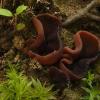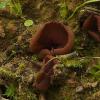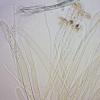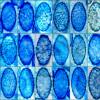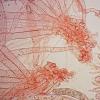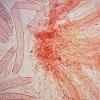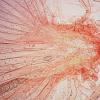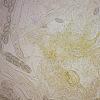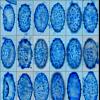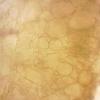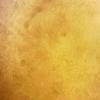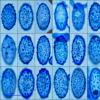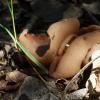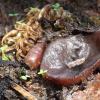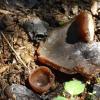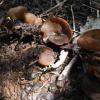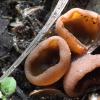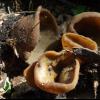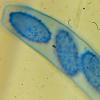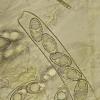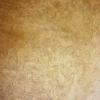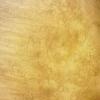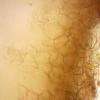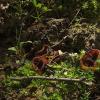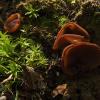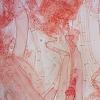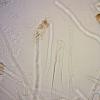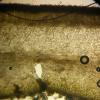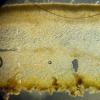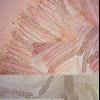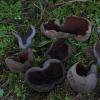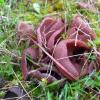
10-09-2025 23:53
 Marcel Heyligen
Marcel Heyligen
Found on Robinia pseudoacasia together with Diapor

11-09-2025 16:57
Our revision of Marthamycetales (Leotiomycetes) is

10-09-2025 17:18
 Blasco Rafael
Blasco Rafael
Hola, encontre este estiercol de vaca estos apotec

02-09-2025 11:34
Thomas Læssøehttps://svampe.databasen.org/observations/10527903

03-09-2025 21:59
Philippe PELLICIERLa Léchère, Col de la Madeleine, alt 1970m, au s

07-09-2025 11:34
 Zuzana Sochorová (Egertová)
Zuzana Sochorová (Egertová)
Hello,I have identified this fungus as Hymenoscyph
sp:
(15.62) 16.09 - 17.70 (18.52) × (7.15) 7.86 - 9.13 (9.25) µm
Q = (1.78) 1.83 - 2.12 (2.26) ; N = 45
Me = 16.86 × 8.53 µm ; Qe = 1.98
warts up to 1.5 um.
Peziza limnaea ? But no any olivaceus tones on apothecia...

I don't recognize the spore ornamentation of P. limnaea on your photos, and this species have a bit larger ascopores. Your collection may be closer to P. depressa.
The asci you show have croziers.
I checked the excipulum, outer is type globulosa intermixed with t. angularis (according Hohmeyer 1986), inner is t. intricata - this ideal fits into description of P.depressa
Ornamentation (Hohmeyer. 1986, B.Spooner 2001) of ascospores of P.depressa should contain +- regular warts, but i see many ridges (elongated waarts) and warts with some interconnects, irregular on many spores. Moreover (acc. B.Spooner, 2001) width of most spores of P.depressa should fit into 10..12 um. My case is 8..9.5 um. Therefore, I assumed here P.limnaea with some doubts.
Now, a look to the excipulum additionally shows that it is not P.limnaea. I collected a couple more mature species and put them again to make a spore print. I hope that the new microphotos of ornamentation will be better and there will be more accurate measurements of the ascospores that left the asci on their own.
At now, it remains only to consider it close to P.depressa, but not P.depressa.
Q = (1.80) 1.86 - 2.16 (2.40) ; N = 27
Me = 17.74 × 8.77 µm ; Qe = 2.03
Your determination in identifying this species forced me to speak, although I will probably not bring anything new.
Last year, late in the fall, I found Peziz that were similar to yours. I could not identify them so I put in my atlas as "Peziza sp."
You can see photos and description at:
http://grzyby-pk.pl/gat-p/peziza-20191008.php
This year I found the same species in the same place. I wondered why last year they grew in late autumn and this year in spring. The explanation is rather simple. Last year, it was very dry since early spring, which meant that no mushrooms grew. It wasn't until late autumn that the rainfall increased slightly. This year is completely different. Rains, although not very abundant but occur regularly.
You mention that you haven't seen the olive shades. For me, not all fruiting bodies had an olive shade.
Initially, I also found them to be P. limnaea, but spore ornamentation was inappropriate for this species. The macro features were similar to P. depressa so I took this species into consideration but the ornamentation also did not match this species.
I think it could be the same genre?
The size of the spores is very similar, also the ornamentation.
The intricate texture you are presenting does not look typical. As in my sporocarps, medullary excipulum also consists of oval cells.
Unfortunately, but this year because of the lack of time, I did not take good micro photos. I put some macro photos and a view of the spores.
Compare if you want.
best regards
Mirek
As you probably noticed, I was also considering this species.
According to Hohmayer, even spores would match this species, but as you probably know, this taxon is considered Mediterranean. So maybe the climate is changing and it is already here?
If I may ask: what region of Russia does your find come from?
However, it is generally believed that P. berthetiana has slightly smaller spores.
This genus is getting more and more difficult, there are many transitional forms and the variability of some species is surprising, such as P. limnaea, for example.
P. michelli, which is a very common species in my area, also often surprises me with its appearance.
Mirek
About P.berthetiana I read first from your link. Even if i think that P.berthetiana species can grow so north, but presence of croziers (after the 2'nd attepmt and Nicolas Van Vooren's hint I clearly found them) excludes it.
Here is some microscopy of P.berthetiana - http://www.ascofrance.fr/recolte/3677/pezizomycetes-pezizales-pezizaceae-peziza-berthetiana
Collection from this link shows wider spores with smaller Q at the same lengths. Spores from that collection are longer than described in Hohmeyer's key.
But here is no match with my specimens: croziers(+) and no brown pigment in paraphyses (i attached additional two photos about this). My specimens can't be P.berthetiana.
Now i was read "CONTRIBUCIÓN AL ESTUDIO DEL GENERO PEZIZA (Dill.) L. ex St. Amans EN ESPAÑA" by TORRE & CALONGE, and found P.atrospora with similar description (spores, ornamentation, excipulum), but also with brown pigment in paraphyses (not my case), and most spores with one big guttule (in my case amount of spores with single guttule is +-equal to amount of biguttulate spores ).
Do you think these samples can belong to the P.atrospora / P.badioconfusa / P.kallioi group?
WBR, Sergey.

Not easy to provide a name for this collection, the only thing I can say that it belongs to the new genus Legaliana (with P. badia as type species) that I proposed to circumscribe the species with uni- or biguttulate ascospores, ornamented with elongated warts, ± anastomosing in a network. P. limnaea belongs to this genus and probably also P. depressa but depends on which you interpretate this species. All the species are macroscopically rather similar.
I strongly suggest to sequence your collection, it will help to better understand the variations in these species.
FYI, I revised the holotype of P. berthetiana, the spore ornamentation is different and contrary to what Donadini said about the ascus base, there are croziers on this species. They appear in a free configuration and may sometimes looks like "aporynchous".
Sergey.
1200 km may be a lot for us but it is nothing special for a mushroom. I traveled a lot after Russia, but the area around Moscow is unfortunately unknown to me. Too big country to explore the whole.
I am glad that Nicolas was the first to answer, because mine was supposed to be very similar.
Did you mention P. atrospora / P. badioconfusa / P. kallioi? I do not know all species from this group.
You certainly can't compare our collections to P. badioconfusa (= phyllogena). I know her perfectly and the differences are so big I don't see any similarities.
I do not know P.kallioi, but there are opinions that it is a synonym of P. badioconfusa ??
P. atrospora I haven't had the pleasure to find it yet, so I don't know this species, but the literature shows that it is unlikely to be similar?
As can be seen from my description in the atlas, my research led me towards the species that Nicolas confirms, which makes me very happy.
Mirek
I itself don't familiar with P.Phyllogena = P.badioconfusa.
I consulted with Eugene Popov from Komarov Botanical Institute, sending all my data about these specimens. His decision - these specimens are P.phyllogena. He also pointed to a spore shape that is more fusiform than ellipsoidal with more obtuse rounded poles for P.depressa. He gave a link to the paper [1]. I studied this paper, and, additionally I studied description of P.badioconfusa from [2].
It seems that in my case there is a very good similarity with P.phyllogena both in the shape, size and ornamentation of the spores (acc. to [1] - this paper contains a lot of information about variability in spores and ornamentation), in the paraphyses, and in the excipulum structure (acc. [2] as P.badioconfusa). In [2], the structure of the excipulum was described very detailed. Also, according to the original description of P.phyllogena cited in [1], prior to synonimizing to P.badioconfusa, them was small speces up to 1 in. (2.5 cm).
P.atrospora spores are bit wider and bit shorter, with single big guttule, and it have brown pigment in the paraphyses - not good similarity. IMO, brown pigment in the paraphyses is an important feature.
P.kallioi is a synonym of P.phyllogena only "ss. auct", it differs (acc. Harmaya) by violet mycelium and a bit smaller spores. Spores of P.kallioi are within normal variability with P.phyllogena, but unfortunately i didn't look at the mycelium. So, I will consider it a synonym of P.phyllogena.
1. Haffner, J. Pseudoapiculate and apiculate cup fungi - emendation. (Recent findings of ascomycetes XVI). Rheinl.-Pfalz. Pilzjour. 5(1):4-31, 1995
2. Donadini, J. C. 1979. Le Genre Peziza Linn. per St Amans (groupe de Peziza badia). Doc. Mycol. 10(37-38): 49-60
Nikolas,
Unfortunately, i don't have the ability to sequence as an amateur mycologist.
Your opinion is very important to me. What do you think about this ?
I think we misunderstood? I didn't suggest at all that your sporocarps belong to the species P. michelii or P. berthetiana.
You can pawn P. badioconfusa but you don't show the characteristics of this species?
1) First of all, P. badioconfusa is a spring species and does not occur at this time of year. I don't know when it grows in your area and you don't write when you found it?
2) The spores in your collection have regular drops inside. Maybe it is a very changeable genre, but I was studying at least a dozen collections, which I have never encountered.
The content of spores in this species consists of an irregular mass, distributed in poles.
Compare how it looks in others or in my atlas:
http://www.ascofrance.com/search_forum/57972
http://www.ascofrance.com/search_forum/62069
And here a small note: you present spores in various media and, above all, to assess their content, first of all the preparation should be made in H2O. Chemicals distort the image!
3) You don't show exactly the layers of the fruiting body. P. badioconfusa has a clearly visible middle layer composed of the texture intricata (see attached photo).
4. P. badioconfusa is easy to recognize even without a microscope. Its outer surface almost always has a slightly purple hue. If it is not visible, the cross-section of the fruiting body should be viewed under a magnifying glass, the layers are perfectly visible even without using a microscope.
If such features are present in your collection then I am inclined to agree with you.
Several species have similar spores. Suggesting only the appearance of spores (ornamentation) can be misleading.
Mirek

P. phyllogena (= P. badioconfusa) is a spring cup-fungus and its spore content is different, with polar granules not true oil drops. It is now part of the new genus Phylloscypha.
I have no experience of P. atrospora but I don't believe in this hypothesis.
I stay on my position: your collection may belong to Legaliana, close to P. limnaea and P. depressa-like fungi.
Keep this collection in your herbarium, it may be useful for future works.
Dear All!
After additional consultations with Eugene Popov (incl. about guttules in the spores), he proposed a new prelimiary version: Peziza limnaea ss. Maas Geest. pro parte (non ss. Grelet) and suggested sequencing it. Dried specimens will be sent to him for sequencing.
Maas Geesteranus, R.A. 1967. Studies in cup-fungi - I. Persoonia. 4(4):417-425 - as P.limnaea;
Maas Geesteranus, R. A. (1967) De Fungi van Nederland II. Pezizales - deel I. - Wetenschappelijke Mededelingen van de Koninklijke Nederlandse Natuurhistorische Vereniging 69: 1-84 - as P.limosa
IMO, my fungus fits well into the descriptions given by Maas Geesteranus in these papers. His descriptions are different in the spore ornamentation from original description of P.limnaea.
I added new microphoto with guttules - red in Congo-SDS, white in the pure water.
Solo una apreciación en cuanto a P. phyllogena.
He leído que P. P. phyllogena (= P. badioconfusa) es un hongo primaveral, esto es cierto, pero existe una forma de P. phyllogena completamente invernal, P. phyllogena var aguilarensis, muy frecuente en un lugar muy cerca de mi ciudad de Ronda, sur de España, en una dehesa de Quercus ilex con suelo muy arenoso, creciendo siempre en los meses de diciembre-enero, microscópicamente no he visto diferencia, solo el color más violáceo de los ascomas y la época de aparición separan estas dos especies.
Supongo que ahora tenemos que llamarla Phylloscypha phyllogena var aguilarensis.
Saludos a todos.
@ Sergey
I do not have the second publication item you mentioned. If someone has it in electronic form, I would like to share it with me. Thanks in advance.
On the other hand, if we consider the first-mentioned publication, the spores shown there are more suited to my collection, which is presented on the site;
http://grzyby-pk.pl/gat-p/peziza-limosa.php
In fact, I could put it on the P. limnaea website, but the differences are so significant that I decided to devote a separate page to it. Is it right? - time will tell.
@ Valencia
I do not know about Spain, but in Poland I find both dark and lighter fruiting bodies at the same time of the year. You can view some of them on the website;
http://grzyby-pk.pl/gat-p/peziza-badioconfusa.php
As you will notice, all collections were collected in May-June. However, I noticed one dependence: fruiting bodies growing in sunnier places, they are more purple in color.
best regards
Mirek
Sí, es cierto lo que comentas, P. phyllogena es muy variable, por mis zonas de prospección lo habitual es encontrarla con colores pardo oscuro o color oliva.
Lo que más llama la atención de esta peziza invernal es su época de aparición, tal vez estos colores violeta/violeta oscuro estén influenciados por las bajas temperaturas, gracias por mostrar el sitio web con las bonitas fotos.
Saludos
Curro
I already have my age, so I remember winters when in my area, in January and February, the temperatures dropped to minus thirty degrees below zero and there was at least a meter of snow. It is difficult for mushrooms of the genus Peziza to grow in such conditions. I envied you a bit, you had it much warmer. Now we have warmer winters and I am beginning to miss the old snowy winters.
This situation has its advantages but also disadvantages. Snowless winters actually allow a variety of fungi, mostly small Heliotales, to grow. However, they have a negative effect on the population of larger Ascomycota, such as Sarcoscypha and its like. The snow layer protected them from freezing. Despite the global warming, representatives of the genus Peziza do not appear in my winter yet ... but who knows, maybe in a few years they will already grow?
best regards
Mirek


